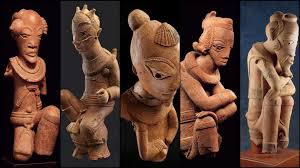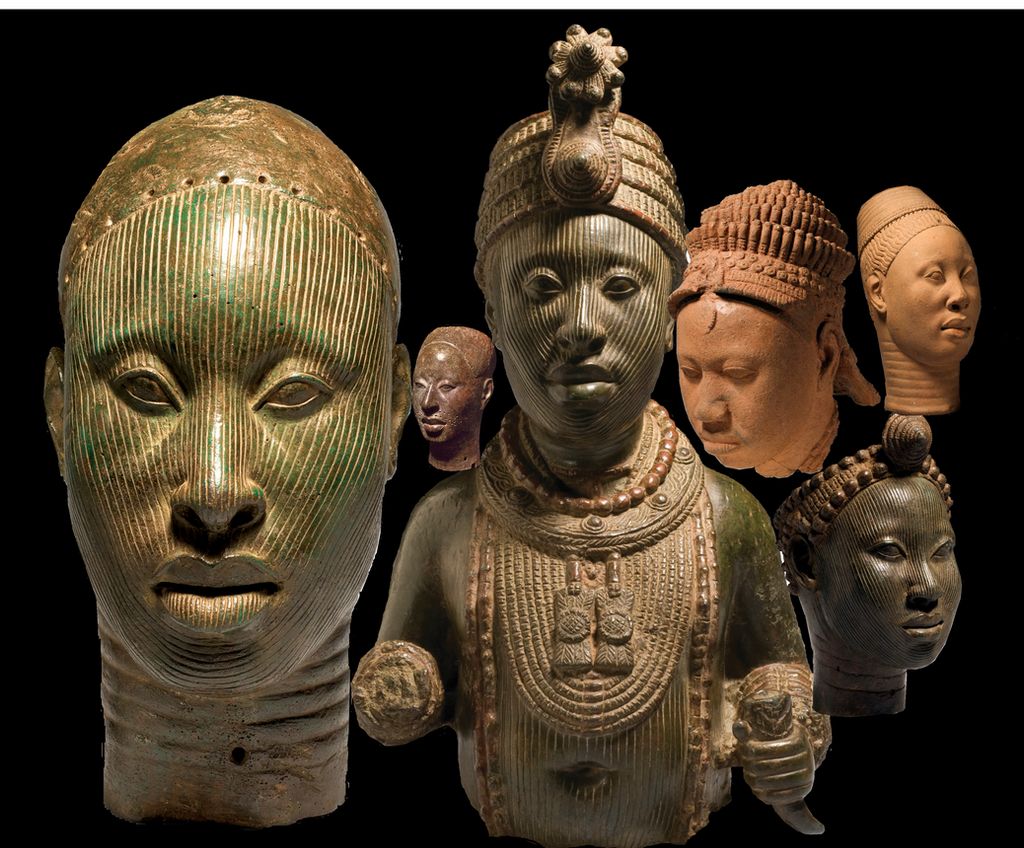G.O. SODIPO & CO.
Cultural property has always been attractive to humanity all over the world. This attraction has stemmed from the traditional significance, craftsmanship and beauty possessed by cultural property. During warfare, cultural properties are looted, destroyed or acquired as spoils of war or as payment for troops on the victorious side. Cultural property includes sculptures, paintings, literature, ceremonial objects, craftwork, intangible objects and other innumerable forms of aesthetic manifestation. 1 It is estimated that 90 to 95 per cent of Africa’s cultural heritage is outside the continent and is now held by prominent museums worldwide.2 Most of these objects were looted during colonization, ethnographic missions, European wars or acquired under questionable conditions and auctions. The looting is arguably illegal under today’s international treaties3.

Credit: Nairaland forum https://www.nairaland.com/6264920/first-nigerians-settlers-outer-space
In Nigeria, the Benin bronzes, Nok terracotta heads, Ife terracotta and bronze heads, Igbo-ukwu art are prominent looted cultural property, and for a decade, there have been discussions on the repatriation of these artworks. The Benin bronzes have been a significant talking point due to the quantity looted and their cultural significance. Germany, which has the second-largest collection, recently promised to return 1,200 objects. The President of France, Emmanuel Macron, has been similarly receptive to the idea that France should return all objects taken by force or presumed to be acquired through inequitable conditions as soon as possible4. In March 2021, the University of Aberdeen agreed to return the Benin bronze head in their possession, and a proposed regulation to guide the repatriation process has been presented. The University of Cambridge wants to return the Akuko, but only wants to discuss Oba’s palace. Several museums in England, and the United States of America have expressed desires to return the cultural properties irrespective of how they were acquired.
Currently, there is a debate between the Edo state government and the Oba of Benin as to who should take custody when the Benin bronzes return. The Edo state governor Godwin Obaseki proposed that the Edo state Museum of West African Art be funded by a Legacy Restoration Trust Ltd, where the Benin bronzes would be housed. However, the Oba of Benin opposes the state government’s decision, stating that the bronzes would be housed in the proposed Benin Royal Museum to be sited at the palace. This controversy raises the issues of who is the rightful owner of the Benin bronzes and who should take custody of these objects.
Before the advent of modern intellectual property, communal ownership of intellectual property was in existence with works ranging from folklore, dramas, sculptures, drawings, designs on calabash, leather works. These works were owned by communities organized in families, clans, age groups, guilds and were equally protected by royal decrees, magical beliefs, and taboos; fines and deaths were sanctions attached to illegal copying of such works. The Benin bronzes were made especially for the king for rituals and traditional ceremonies; only guild members could create and recreate such works. Guild members were initiated mainly by gods and ancestral spirits, which protected and punished erring members or infringing non-members. As a result, non-members refrained from carrying out activities reserved for members of a guild.5 Even though the current intellectual property law regime does not recognize communal ownership of Intellectual Property Rights, Benin bronzes were commissioned by the king and owned by him and his descendants. However, the current intellectual property regime would raise the question of whether members of the guild and their descendants have a right to these bronzes. The intellectual property law recognizes ownership of rights in collective works; the person who commissions creators to create distinct pieces in a collection is the initial owner of the collective work but not the owner of the different works in the collection. From the foregoing, the guild members also have a right to the Benin bronzes. As a result, the king and the guild members are joint owners of the Benin bronzes.

Credit: Bronze and terracotta heads excavated in Ife, Nigeria, (XIIth-XIVth Century): https://artkarel.com/the-bronze-heads-of-the-kingdoms-of-ife-and-benin/
Due to the importance and significance of the repatriation of cultural property, countries have set laws and policies to regulate the process of repatriation. The Nigerian Constitution vests the right to make laws on antiquities on the exclusive list, on the federal government6. This means that state governments cannot make laws on antiquities. Pursuant to this, the extant Federal law on cultural property in Nigeria is the National Commission for Museums and Monuments Act (NCMM Act). The Act does not explicitly define cultural property, but it can be deduced from its definition of antiquity. The Act defines antiquity as “any object of archaeological interest or land in which any such object was discovered or is believed to exist; or any relic of early human settlement or colonization; or any work of art or craft work; including any statue, model, clay, figure, figure cast or rust metal, carving, house post, door, ancestral figure, religious mask, staff, drum, bolt, ornament, utensil, weapon, armor, regalia, manuscript or document if such work of art or craft work is of indigenous origin and (i) was made or fashioned before the year 1918; or (ii) is of historical, artistic or scientific interest and is or has been used at any time in the performance and for the purposes of any traditional ceremony and in the case of any object or relic mentioned in paragraph (a) or (b) of this section includes for the purposes of this Act any land adjacent thereto which in the opinion of the Commission, a State Government or, as for the purpose of maintaining the same or the amenities thereof or for providing or facilitating access thereto, or for the exercise of proper control or management with respect thereto”.7
The NCMM recognizes private ownership of antiquities. By its definition of the owner, it includes a joint owner invested with powers of management of antiquity on behalf of himself and other joint owners, any agent or trustee exercising such powers and the attorney of any such person. The ownership of cultural property can transfer to the state if the Commission considers it expedient that antiquity (other than a monument) should be preserved in a museum, and with the knowledge of the State Government concerned, arrange for the purchase or loan of the antiquity and its removal to a national or other approved museum8.
The Act further provides where antiquity is declared as a national monument; the owner would be entitled to compensation for the value at the date of the declaration, and all rights, title, estate and interest in such antiquity shall be extinguished9.
The ownership of the Benin, Ife, Nok and Igbo-ukwu cultural properties is unquestionable. A significant part of the history of the societies concerned are hidden abroad. However, the debates surrounding the return of Nigerian’s “looted” cultural property raise several legal and ethical issues. Can private collectors of these properties hide under the principle of being purchasers for value without notice, where the properties are arguably “stolen” property? Can the University of Cambridge maintain its position that it will only discuss with the Oba’s palace and not the federal government of Nigeria? How ethical and politically correct is the position of the British Museum that it can only return the loot if a law is passed enabling it to return the loot? Can the Nigerian government issue proceedings against the British government in any court? Given the gains by the foreign museums from exhibiting and holding these properties over the years, can claims for compensation be made by Nigeria? Who bears the costs of the “repatriation” of these properties to Nigeria?
By Aderinsola Adeliyi
aderinsola.a@gosodipo.com
REFERENCES
1 Henry Akinburio ‘Nightmares for looted Benin artefacts’ The Sun (Lagos, 10 August 2021) accessed 6 September 2021.
2 F. Nayeri, ‘Museums in France Should Return Cultural Property, Report Says’, The New York Times (21 Nov 2018) < https://www.nytimes.com/2018/11/21/arts/design/france-museums-africa-savoy-sarrreport.html > accessed 6 September 2021
3 The UNESCO 1970 Convention on the Means of Prohibiting and Preventing the Illicit Import, Export and Transfer of Ownership of Cultural Property. UNIDROIT Convention on Stolen or Illegally Exported Cultural Objects (Rome, 1995)
4 Adewale Maja-Pearce ‘Who Really Owns the Benin Bronzes? ‘ The Spectator (5 September 2021) < https://niyitabiti.net/2021/09/who-really-owns-the-benin-bronzes/ > accessed 6 September 2021
5 Bankole Sodipo: Piracy and counterfeiting GATT TRIPS and developing countries (International Economic Development Law Series, Vol.5) 44
6 Part 1 Exclusive Legislative List Item 60 (a) (b) and (c)
7 The National Commission for Museums and Monuments Act (NCMM Act) Cap N19, Laws of the Federation of Nigeria 2004, Section 32.
8 Section 12 (c) NCMM Act.
9 Section 17 NCMM Act.
To download this article click here:
https://gos-law.com/download/the-repatriation-of-the-stolen-benin-ife-nok-igbo-ukwu-cultural-properties/
For more articles like this click the link below:

